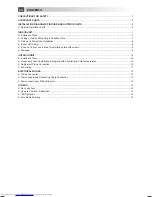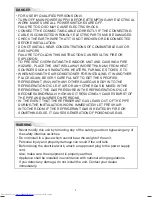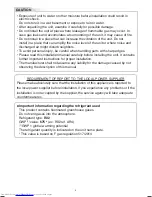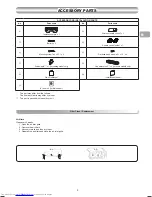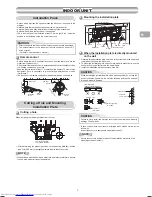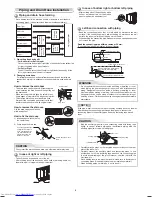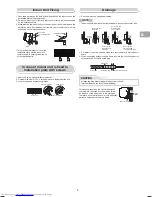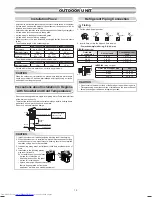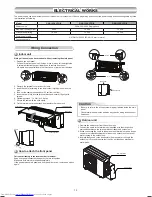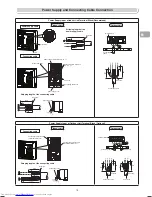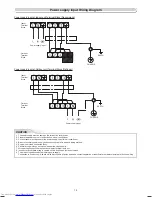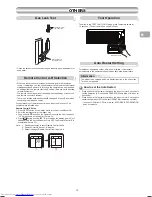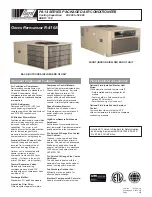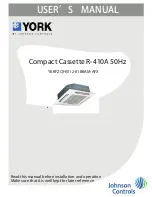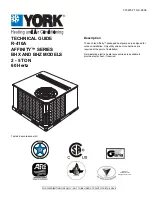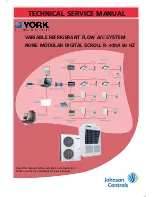
EN
11
Flare at indoor
unit side
Flare at outdoor
unit side
Flare nut
Half union
Externally
threaded side
Internally
threaded side
Use a wrench to secure.
Use a torque wrench to tighten.
CAUTION
Align the centers of the connecting pipes and tighten the flare nut as far as
possible with your fingers. Then tighten the nut with a spanner and torque
wrench as shown in the figure.
Tightening connection
Do not apply excess torque. Otherwise, the nut may crack depending on
the conditions.
(Unit : N·m)
Outer dia. of copper pipe
Tightening torque
Ø6.35 mm
14 to 18 (1.4 to 1.8 kgf·m)
Ø9.52 mm
33 to 42 (3.3 to 4.2 kgf·m)
Ø12.70 mm
50 to 62 (5.0 to 6.2 kgf·m)
Evacuating
After the piping has been connected to the indoor unit, you can perform the
air purge together at once.
AIR PURGE
Evacuate the air in the connecting pipes and in the indoor unit using a
vacuum pump. Do not use the refrigerant in the outdoor unit. For details,
see the manual of the vacuum pump.
• Tightening torque of flare pipe connections
The operating pressure of R32 is
higher than that of R22 (approx.
1.6 times). It is therefore necessary
to firmly tighten the flare pipe
connecting sections (which connect
the indoor and outdoor units) up to the
specified tightening torque. Incorrect
connections may cause not only a
gas leakage, but also damage to the
refrigeration cycle.
Be sure to use a vacuum pump with counter-flow prevention function so that
inside oil of the pump does not flow backward into pipes of the air conditioner
when the pump stops.
(If oil inside of the vacuum pump enters the air conditioner, which use R32,
refrigeration cycle trouble may result.)
1. Connect the charge hose from the manifold valve to the service port of the
packed valve at gas side.
2. Connect the charge hose to the port of the vacuum pump.
3. Open fully the low pressure side handle of the gauge manifold valve.
4. Operate the vacuum pump to start evacuating. Perform evacuating for
about 15 minutes if the piping length is 25 meters. (15 minutes for 25 meters)
(assuming a pump capacity of 27 liters per minute) Then confirm that the
compound pressure gauge reading is –101 kPa (–76 cmHg).
5. Close the low pressure side valve handle of the gauge manifold valve.
6. Open fully the valve stem of the packed valves (both gas and liquid sides).
7. Remove the charging hose from the service port.
8. Securely tighten the caps on the packed valves.
Using a vacuum pump
Packed valve at liquid side
Service port (Valve core (Setting pin))
Packed valve at gas side
Vacuum
pump
Vacuum pump adapter for
counter-flow prevention
Charge hose
Handle Hi
(Keep full closed)
Manifold valve
Pressure gauge
Compound pressure gauge
Handle Lo
Charge hose
Connecting pipe
–101 kPa
(–76 cmHg)
CAUTION
• KEEP IMPORTANT 6 POINTS FOR PIPING WORK.
(1) Take away dust and moisture (inside of the connecting pipes).
(2) Tighten the connections (between pipes and unit).
(3) Evacuate the air in the connecting pipes using a VACUUM PUMP.
(4) Check gas leak (connected points).
(5) Be sure to fully open the packed valves before operation.
(6) Reusable mechanical connectors and flared joints are not allowed
indoors. When mechanical connectors are reused indoors, sealing
parts shall be renewed. When flared joints are reused indoors, the
flare part shall be refabricated.
Packed valve handling precautions
• Open the valve stem all the way out, but do not try to open it beyond the
stopper.
• Securely tighten the valve cap with torque in the following table.
Pipe size of Packed Valve
Size of Hexagon wrench
12.70 mm and smallers
A = 4 mm
15.88 mm
A = 5 mm
A
H
Hexagon wrench
is required.
Cap
Cap Size
(H)
Torque
Valve Rod
Cap
H17 - H19
14~18 N·m
(1.4 to 1.8 kgf·m)
H22 - H30
33~42 N·m
(3.3 to 4.2 kgf·m)
Service
Port Cap
H14
8~12 N·m
(0.8 to 1.2 kgf·m)
H17
14~18 N·m
(1.4 to 1.8 kgf·m)
Service Port Cap
Valve Rod Cap
01_1121451198-EN.indd 11
4/26/2561 BE 10:06 AM


